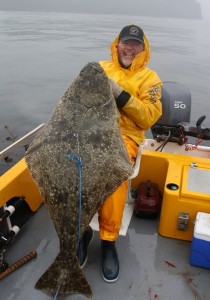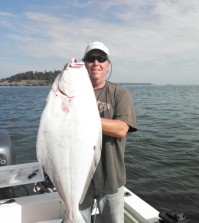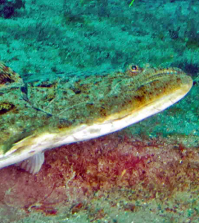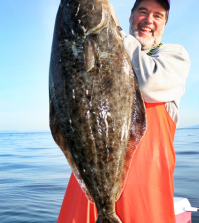Gearing up for Halibut
Interest in halibut fishing continues to grow here in the Pacific Northwest, so every year about this time hundreds of newcomers to the sport join thousands of halibut-fishing veterans as they flock to tackle stores and on-line shopping sites to buy rods, reels, line, terminal tackle and related equipment for their assault on the Pacific halibut, the Northwest’s trophy saltwater bottomfish.
If you’re gearing up for your first-ever halibut season—or maybe looking to update your equipment for the first time since 1981—the most important thing to consider is HOW DEEP you’re likely to be doing most of your fishing, not HOW BIG a halibut you think you might catch. Halibut fishing often means deep-water fishing, especially down here in the southern portion of the halibut’s range, from southern British Columbia to the north coast of California, and if you venture onto the deep-water fishing grounds with undersize tackle, you won’t have to worry about how big a halibut you’ll hook because you won’t be hooking any. In this part of the country, most halibut are taken from 200 to 350 feet of water, sometimes 400, 500, 600 feet or more! To reach those depths, lure and sinker weights are measured not in ounces but in pounds, because it takes that much weight to reach the bottom, where the halibut live. You can’t fish three-pound sinkers on steelhead drift rods and 12-pound mono, so you have to match rods, reels and line to the kind of terminal gear you’ll be fishing, not to the 20-pound halibut you might be dredging up from those extreme depths.
On the other hand, as you make your way up the Pacific coast into northern British Columbia and Alaska, you’ll not only find a higher percentage of larger halibut, but you’re likely to find them in shallower water. Every year anglers along the west and north sides of the Queen Charlottes, throughout Southeast Alaska, Cook Inlet and the Aleutian Islands catch hundreds of good-sized halibut in 75 to 250 feet of water. At those depths you may be able to reach bottom with sinkers, pipe jigs or leadheads as light as five or six ounces on a slack tide, a little heavier when the tide starts to run. The rod, reel and even the line needed to fish the lighter terminal rigs can be a lot smaller, too.
With that in mind, here are some tackle suggestions for those looking to spend some of their fishing allowance on halibut gear:
Rods
Needless to say, a rod that might be called upon to lift and drop a 24- to 48-ounce sinker all day is gonna need some backbone. If your terminal gear alone puts a 60-degree sag in it, the rod has too much give for decent hook-setting and runs a high risk of blowing up completely under the weight of a decent-sized halibut. But a cue stick with no action at all isn’t good either; you want it to bend at least a little to absorb the shock of that 50-pound bucking ‘but down there at the other end of your line, especially when your line is a no-stretch braid (which we’ll be talking about later). A rod that won’t bend and a line that won’t stretch is a combination that leaves little margin for error when you’re playing a big, strong fish. If you want to get an idea of how well a halibut rod might handle a load, take a 48-ounce (3-pound) cannonball sinker and short length of line into the store with you and hang it from the rod tip. If it doesn’t bend at all it’s too stiff and if the tip sags half-way to the floor it’s way too light; somewhere in-between is the range you’re looking for.
Keep in mind, too, that a rod with a fairly heavy action isn’t necessarily heavy in pounds and ounces. There are rods out there these days that are extremely tough, well-made and strong enough to handle any halibut, while weighing so little that you can fish them all day without feeling like you just finished a decathlon. A heavier rod isn’t necessarily harder on halibut, but it’s definitely harder on halibut fishermen.
As for length, there’s a fairly wide range of opinions on what constitutes the “perfect’ halibut rod, from five feet to eight feet. I don’t like rods at the short end of that spectrum because I don’t feel like I’m getting enough lift when I’m trying to yo-yo a bait or lure along the bottom in 400 feet of water. At the other extreme, I haven’t found many rods over seven feet long that are beefy enough for fishing heavy gear in deep water. My favorite halibut rods are all between six and seven feet long.
Some anglers like roller tips at the business end of their halibut rods, some don’t; I’m one of those who likes ‘em a lot. I think they’re especially useful in helping braided lines maintain their shape and reducing the friction that can damage any line. I’m a serious hook-setter, and I’ve never had a line break at the tip on a set with rollers; it’s happened three times with standard tip guides, all when I was fishing braid.
Other things to look for in a halibut rod? You want quality guides that are well-wrapped and finished; a sturdy reel seat of either stainless steel or molded graphite (a clamp adds strength but the two bolt ends can gouge your hands if you’re not careful); a fore grip that’s comfortable and fits your hand; a butt that’s long enough to keep the reel well out in front of your body.
Reels
Any reel used for saltwater fishing should be tough and made to withstand the corrosive abuse dished out by constant exposure to the marine environment, but two specific variables are especially important in a reel that’s going to be used in deep water for large, strong fish: line capacity and gear ratio.
The line-capacity issue should be pretty obvious when you’re talking about fishing in depths of 350 to 600 feet. Keep in mind that when you’re fishing at a 500-foot depth you can’t get by with only 500 feet of line on your reel. When you’re halibut fishing in deep water you’re rarely fishing straight down, so you may have to pay out 600 feet of line to reach bottom in 500 feet of water. Then, if you hook a good ‘but that decides to head for parts unknown when you stick it, another 100 feet of line might melt off the reel before you start gaining on it. And, if your reel’s line capacity is a mere 500 feet, how are you going to reach bottom on the next drift should you hang-up and snap your line at the rod tip while fishing 300 feet down? You want enough line to keep fishing even if you lose half of it to a break-off.
To accommodate all those potential situations, most veteran halibut anglers like to keep their reels filled with at least twice as much line as they expect to need in a worst-case scenario. So, for fishing in up to 500 feet of water, they’d want a minimum of 1,400 feet of line on the spool (500 [depth] + 100 [scope] + 100 [fish runs] x 2 [break-off]). It takes a pretty good-sized reel to hold 1,400 feet of line, even if it’s small-diameter braid.
As for a reel’s gear ratio, it has to be pretty low, unless part of your reason for halibut fishing is to get a full-body workout every time you hook a fish. High-speed reels with gear ratios of 6:1 or even 7:1 are becoming popular on a lot of fishing fronts these days, which is fine for chasing those high-flyers and surface-screamers, but halibut are neither of the above. For flatties you want a reel that’s geared low enough to give you some cranking power when you’re trying to winch 75 pounds of bottom-hugger up from the depths. To me, that means a reel with a gear ratio of 4.5:1 or lower, and 2:1 to 3:1 is even better.
But, we don’t hook a halibut on every drop (at least I don’t), and reeling a 32-ounce sinker up from 450 feet to check your bait or start a new drift is slow, tedious work with a low-geared reel, costing you valuable fishing time. The solution, of course, is a two-speed reel, one geared to allow 4:1 or 5:1 retrieval speed when you’re coming up fishless and 2:1 power when you shift down into granny-low. Such reels have been around for more than 20 years, and they merit serious consideration from Northwest halibut anglers.
You can spend $500 to $1,000 for a higher-end two-speed reel, but there are also some good ones out there in the $250 to $400 range. They include Shimano’s Tyrnos TYR 30II (5.0:1 and 2.0:1 gear ratios), and Lever Drag TLD 20II and TLD 30II (4.0:1/1.7:1), Penn’s GraphLite GLD 20II (3.6:1/2.0:1) and Okuma’s Solterra SLR 30II (3.8:1/1.7:1). All five are large enough to hold at least 1,500 feet of 80-pound ultra-braid line.
Line
By now you already know that I use and recommend nothing but braided line for halibut fishing. I’m old enough to have been fishing for these goofy-looking things for about 40 years, the first 10 or so with monofilament, then braided Dacron, and finally, some 20 years ago, with the first of what is now a long line of “super-braids” woven of Spectra and other new-age microfibers. Today’s braids are exactly what the doctor ordered when it comes to halibut fishing. Their small diameter allows the use of lighter sinkers and lures to reach greater depths, and you can put a lot more and heavier line on a reel than with the larger-diameter monos and Dacron braids. Because they don’t stretch, braids give a much better “feel” of the bottom and telegraph strikes much better than other lines, and also transmit a lot more energy to the other end of the line when you set the hook.
There’s a fairly wide range of opinions on the “best” strength, color and brand of braided line for halibut fishing. Some folks go as light as 50-pound, some as heavy as 130-pound; I like 80-pound braid when fishing around here and sometimes jump up to 100-pound when fishing the North Country. As for color, the high-visibility yellow, green and red lines make it easier to keep track of line angles and to unravel tangled lines, but usually I go with the more subtle natural greens and grays (for no particular reason). I’ve had great luck with SpiderWire Stealth and use it to fill most of my halibut reels, but I have fishing buddies using Power Pro, Tuf Line, Sufix and Ripcord, all with no complaints.
Whatever braid you choose, it ain’t cheap. You’ll spend $35 to $70 for enough 80-pound braid to fill most halibut reels. That is, if you use only super-braid to fill it; lots of folks use a couple-hundred yards of less-expensive monofilament or braided Dacron backing. I don’t use backing, but if you do, I recommend Dacron over mono, because it’s easier to get a good connecting knot between the braid and the backing.
Terminal Tackle
A high percentage of halibut are caught on bait, usually whole herring, so you’ll need to stock up on wire spreaders, cannonball sinkers ranging in size from 12 to 48 ounces, a supply of 8/0 to 10/0 hooks and a spool of good leader material. Some folks like wire leaders, but I’ve yet to have a halibut chew through 50- or 60-pound Berkley Big Game monofilament. As for those hooks, some prefer circle hooks, but I use “J-hooks,” usually Owner SSW Cutting Point octopus hooks.
Artificial lures can also be effective for halibut, especially pipe jigs, metal “slab” jigs and leadheads adorned with large plastic grub bodies. Like your sinkers, those jigs have to be heavy if they’re going to reach bottom. Store-bought slabs and leadheads weighing 16 to 32 ounces cost big bucks, but you can make your own pipe jigs for less than a dollar each if you have the raw materials (lead and copper pipe). The other advantage in making your own jigs is that you can use pipe of various diameters and various lengths to build lures as large or as small as you need.
Your tackle arsenal should also include a supply of large ball-bearing swivels for connecting braided line to mono leaders. It’s a good idea to use a two-foot mono shock leader between line and lure, and I use the same 50- or 60-pound Big Game that is use for bait leaders. When using jigs, it’s often helpful to fish a “teaser” above the jig, and that in-line swivel connecting line and leader is a good place to tie the short teaser leader. Add a small grub tail, strip of fish skin or pork rind to the teaser hook and you’re ready to go.
Accessories
Hooking a halibut is only half the battle; landing it is the other half, and you need a couple of important tools to help you accomplish phase-two of the operation. A good gaff will do the job on fish of 50 pounds or smaller. I’ve been using my four-foot AFTCO gaff on hallies for over 20 years, and it has at last 20 more left in it.
For larger halibut, a harpoon with a flying head is a better—and safer—way to go. You might also want to invest in a large, inflatable boat buoy and tie it to the end of your harpoon line, rather than hanging onto that line or lashing it to a boat cleat when you have a big, angry halibut on the other end.
Another useful halibut-fishing accessory, especially if you’re using heavy tackle in deep water, is a fighting belt. Some people call them a sissy belt, but they can make the job of cranking a big fish off the bottom a heck of a lot easier. They can cost as little as $15.











